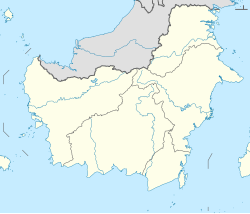
South Kalimantan is a province of Indonesia. It is the smallest province in Kalimantan, the Indonesian territory of Borneo. The provincial capital was Banjarmasin until 15 February 2022 when it was legally moved to Banjarbaru. The population of South Kalimantan was recorded at just over 3.625 million people at the 2010 Census, and at 4.07 million at the 2020 Census. The official estimate as at mid 2022 was 4,182,080. One of the five Indonesian provinces in Kalimantan, it is bordered by the Makassar Strait in the east, Central Kalimantan in the west and north, the Java Sea in the south, and East Kalimantan in the north. The province also includes the island of Laut, located off the eastern coast of Kalimantan. The province is divided into 11 regencies and 2 cities. South Kalimantan is the traditional homeland of the Banjar people, although some parts of East Kalimantan and Central Kalimantan are also included in this criteria. Nevertheless, South Kalimantan, especially the former capital city Banjarmasin has always been the cultural capital of Banjarese culture. Many Banjarese have migrated to other parts of Indonesia, as well as neighbouring countries such as Singapore and Malaysia. In addition, other ethnic groups also inhabit the province, such as several groups of the Dayaks, who mostly live in the interior part of the province, as well as the Javanese, who mostly migrated from Java due to the Transmigration program which dated from the Dutch colonial era.
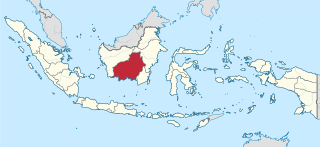
Central Kalimantan is a province of Indonesia. It is one of five provinces in Kalimantan, the Indonesian part of Borneo. It is bordered by West Kalimantan to the west, South Kalimantan and East Kalimantan to the east, Java Sea to the south and is separated narrowly from North Kalimantan and Malaysia by East Kalimantan's Mahakam Ulu Regency. Its provincial capital is Palangka Raya and in 2010 its population was over 2.2 million, while the 2020 Census showed a total of almost 2.67 million; the official estimate as at mid 2022 was 2,741,075.

Banjarmasin is a city in South Kalimantan, Indonesia. It was the capital of the province until 15 February 2022. The city is located on a delta island near the junction of the Barito and Martapura rivers. Historically the centre of the Banjarese culture, and the capital of the Sultanate of Banjar, it is the biggest city in South Kalimantan and one of the main cities of Kalimantan. The city covers an area of 98.46 km2 (38.02 sq mi) and had a population of 625,481 as of the 2010 Census and 657,663 as of the 2020 Census; the official estimate as of mid 2022 was 667,489. Greater Banjarmasin, also known as Banjarbakula, is an urban agglomeration of around two million people covering an area of 8,136 km2 (3,141 sq mi), which includes Banjarbaru city and parts of Banjar Regency, Barito Kuala Regency, and Tanah Laut Regency, and accounts for almost half of the province's population. It is the third most populous city on the island of Borneo.

Palangka Raya is the capital and largest city of the Indonesian province of Central Kalimantan. The city is situated between the Kahayan and the Sabangau rivers on the island of Borneo. As of the 2020 census, the city has a population of 293,500; the official estimate as at mid 2022 was 305,907. Palangka Raya is the largest city by land area in Indonesia. Most of the area is forested including protected forests, nature conservation areas, and Tangkiling Forest). It also has the highest Human Development Index rating of any city in Kalimantan.

Banjarbaru is the capital city of South Kalimantan, one of the provinces in Indonesia. It is located 35 km (22 mi) southeast of Banjarmasin, the largest city of the province. The city had a population of 199,627 as of the 2010 Census, and 253,442 at the 2020 Census, and the official population estimate was 265,575. The town of Martapura lies immediately to the north of Banjarbaru, and in effect constitutes an extension of the city. The second largest city in the province after Banjarmasin, it is also part of Banjarbakula metropolitan area.

The Banjar or Banjarese are an Austronesian ethnic group native to the Banjar regions in the southeastern Kalimantan regions of Indonesia. Nowadays, Banjarese diaspora can be found in neighbouring Banjar regions as well; including Kotabaru Regency, the southeastern regions of Central Kalimantan, southernmost regions of East Kalimantan, and some provinces of Indonesia in general. The Banjarese diaspora community also can be found in neighbouring countries of Indonesia, such as Brunei, Malaysia, and Singapore.

Kotabaru Regency is one of the eleven regencies in the Indonesian province of South Kalimantan. It consists of two parts; the smaller but more populated part comprises Laut Island, the largest island off the coast of Kalimantan, together with the smaller Sebuku Island off Laut Island's east coast and even smaller islands nearby; the larger but less populated part consists of districts on the mainland of Kalimantan. The regency as a whole has an area of 9,480.17 km2, and had a population of 290,142 at the 2010 Census and 325,622 at the 2020 Census. The official estimate as at mid 2022 was 334,158, of whom 178,660 were in the insular part and 155,498 in the mainland part of the regency. The regency seat is located at the large town of Kotabaru at the northern tip of Laut Island.
The Sampit conflict, Sampit war or Sampit riots was an outbreak of inter-ethnic violence in Indonesia, beginning in February 2001 and lasting through the year. The conflict started in the town of Sampit, Central Kalimantan, and spread throughout the province, including the capital Palangka Raya. The conflict took place between the indigenous Dayak people and the migrant Madurese people from the island of Madura off Java.
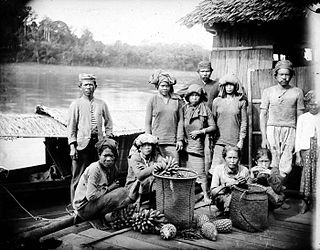
Bakumpai or Baraki are indigenous people of Borneo and are considered as a sub-ethnic group of the Dayak Ngaju people group with Islamic background. The Bakumpai people first occupy along the Barito riverbanks in South Kalimantan and Central Kalimantan, from Marabahan to Puruk Cahu, Murung Raya Regency. The Bakumpai people first appeared as a newly recognized people group in census 2000 and were made up of 7.51% of Central Kalimantan population, which before this the Bakumpai people were considered as part of the Dayak people in a 1930 census.

Gunung Mas Regency is one of the thirteen regencies of Central Kalimantan Province, Indonesia. The regency seat is located at the town of Kuala Kurun in Kurun District. The population of Gunung Mas Regency was 96,900 at the 2010 census ; and 135,373 at the 2020 census; the official estimate as at mid 2022 was 142,309.

East Kotawaringin Regency is one of the thirteen regencies which comprise the Central Kalimantan Province on the island of Kalimantan (Borneo), Indonesia. It originally covered a much larger part of the province, but on 10 April 2002 several districts in the west of the regency were split off to form the new Seruyan Regency, and several districts in the east of the regency were similarly split off to form the new Katingan Regency. The population of the residual East Kotawaringin Regency was 374,175 at the 2010 Census, and 428,900 at the 2020 Census; the official estimate as at mid 2022 was 436,079. The town of Sampit is the capital of East Kotawaringin Regency.

Seruyan Regency is one of the thirteen regencies which comprise the Central Kalimantan Province on the island of Kalimantan (Borneo), Indonesia. It was created on 10 April 2002 from what were previously the western districts of East Kotawaringin Regency. The town of Kuala Pembuang in Seruyan Hilir District is the capital of Seruyan Regency. The population of the Regency was 139,931 at the 2010 Census and 162,906 at the 2020 census; the official estimate was at mid 2022 was 166,072.
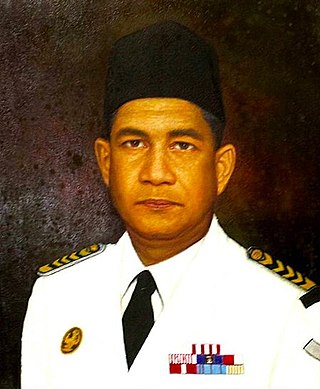
Anakletus Tjilik Riwut, more commonly referred to simply as Tjilik Riwut, was an Indonesian journalist, military officer, and politician, who served as the second Governor of Central Kalimantan from 1959 until 1967, as an Independent. He was also a major figure in the Indonesian National Revolution, becoming one of the leaders of the Kalimantan Physical Revolution in Dutch Borneo after the end of World War II, along with Idham Chalid, Hasan Basry, Mohammad Noor, and a number of other decentralized leaders.

The Sambas riots were an outbreak of inter-ethnic violence in Indonesia, in 1999 in the regency of Sambas, West Kalimantan Province and involved the Madurese on one side and an alliance of the indigenous Dayak people and Sambas Malays on the other. The Madurese and Dayak were inspired by their respective traditions of violence: "carok" for the Madurese and "ngayau" for the Dayak. The Dayak attempt to settle disputes first by means of a peaceful agreement and only practice "ngayau" when they are violently attacked, while the Madurese practice "carok" as a first measure. In this case, the Madurese aggressively murdered some Dayak by using a sword (celurit), so the Dayak responded out of self-defense. As Malays, the Sambas do not have a tradition of violence but allied with the Dayak due harassment of the migrant Madurese over the course of many decades.
Mandau Talawang Pancasila is a paramilitary organization, based mostly within the Indonesian provinces of Central Kalimantan and West Kalimantan.
National Dayak Customary Council is an official customary council of the Dayak people in Indonesia that acts as the highest authority over other cultural or traditional councils of the Dayak people. It has branches from the provincial level to the village level in the entire Kalimantan and is funded by the Indonesian government. It was established on 5 September 2006 after the 2nd National Indonesian Dayak Conference in Pontianak regarding matters of funding the organization and its structure, and has been incorporated into laws by various local governments in Kalimantan. The president of the council is elected by representatives of regional branches for a five year term. The current president of the council from 2021 to 2026 is Marthin Billa, who was previously regent of Malinau Regency and chief of the North Kalimantan provincial Dayak Council.
Batamad, abbreviation from Barisan Pertahanan Masyarakat Adat Dayak, is an official paramilitary under National Dayak Customary Council in Indonesia. It was established in February 2012 with approval of Central Kalimantan provincial government based on Regional Law Number 16 of 2008. Initially, it was created as a response of rising religious extremism in Indonesia, including Central Kalimantan, and the paramilitary was tasked to supervise suspicious religious activities there, particularly those allegedly by Islamic extremism. Other than that, the organization is also tasked to enforce customary laws under Dayak culture, enforcing tribal land claims, as well as protecting rights of Dayak people. It is proposed in 2018 by Central Kalimantan province that the organization would also act as a security personnels during tribal courts. However, outside of its given legal authorities, the organization also participate in enforcing road traffic with Indonesian National Police. The organization has been descibred by local media as an "official tribal police".
Kema Muhammad Aini Usop, or more popularly known as KMA Usop, was an Indonesian academician, politician, Dayak cultural figure, and former political prisoner during the early Reformasi era. He was famous for being accused as a provocator encouraging native Dayaks to kill Madurese migrants in Central Kalimantan, igniting the communal Sampit conflict in 2001. As a result, he was arrested and prevented from leaving the city of Palangka Raya, making him a city prisoner.
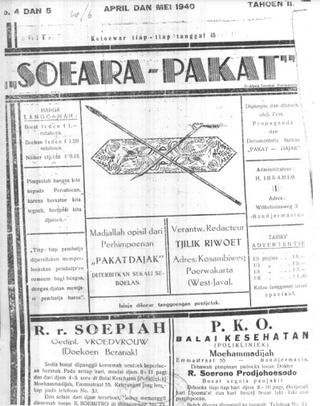
Dayak in politics refers to the participation of Dayaks to represent their political ideas and interests outside of their community. The movement has continued to have a profound impact on the development of Indonesia and Malaysia, especially in Kalimantan and Sarawak.

Hausman Baboe was a colonial head of Kuala Kapuas district of Central Kalimantan in the Dutch East Indies; he was also an early Dayak journalist and an Indonesian nationalist. Baboe was born into an aristocratic family of Dayak Ngaju people and served as head of Kuala Kapuas under the Dutch colonial government but was dismissed from his post due to his anti-colonial remarks. He became a prominent Dayak political figure and was several times accused of being a communist due to his close association with the left-wing political party Sarekat Rakjat. Despite being a Christian, his Indonesian nationalist ideals drew him close to Sarekat Islam.




